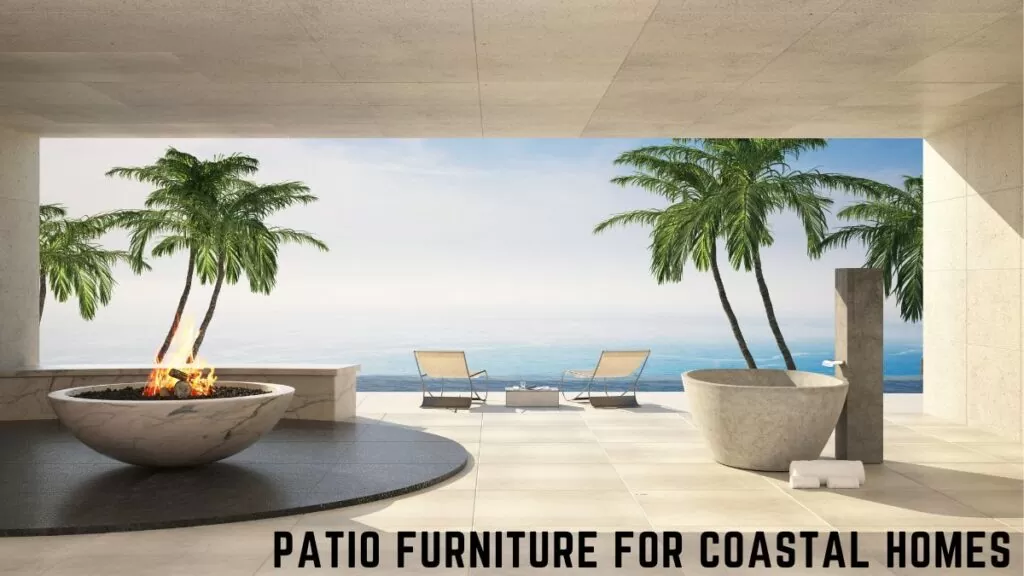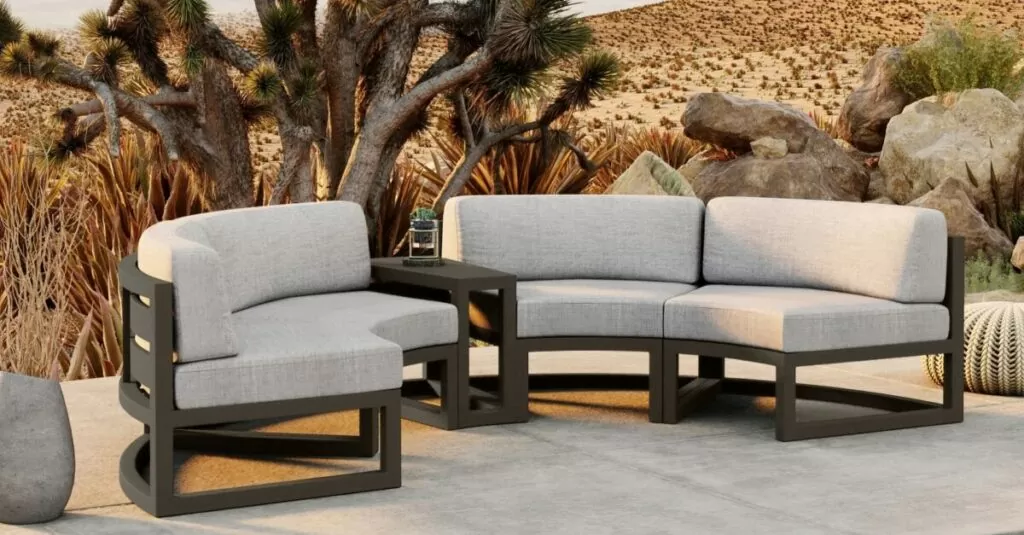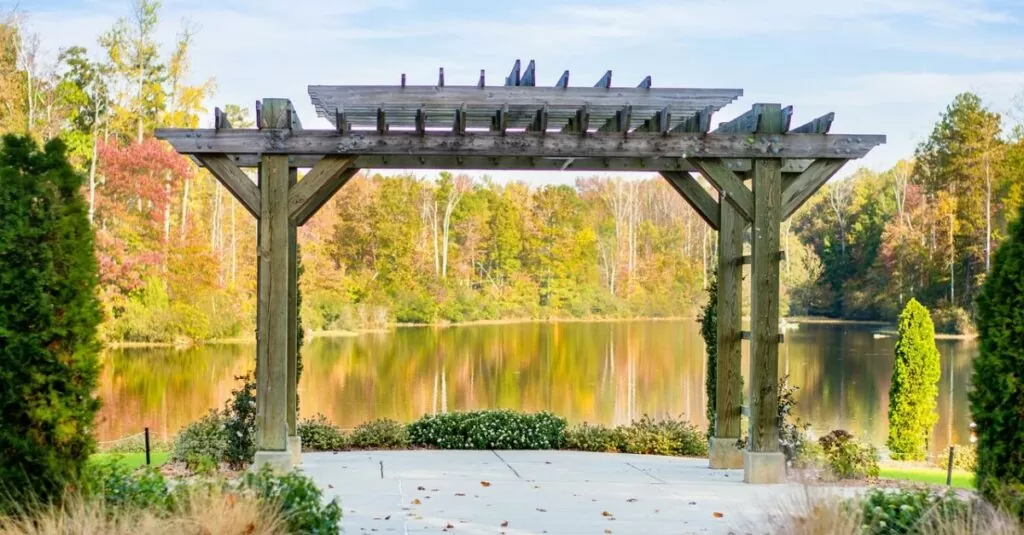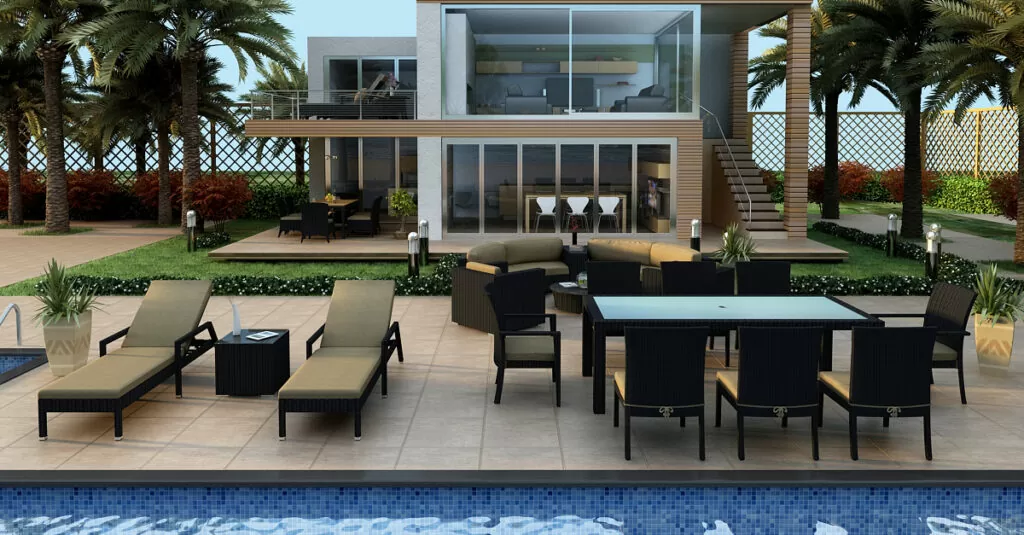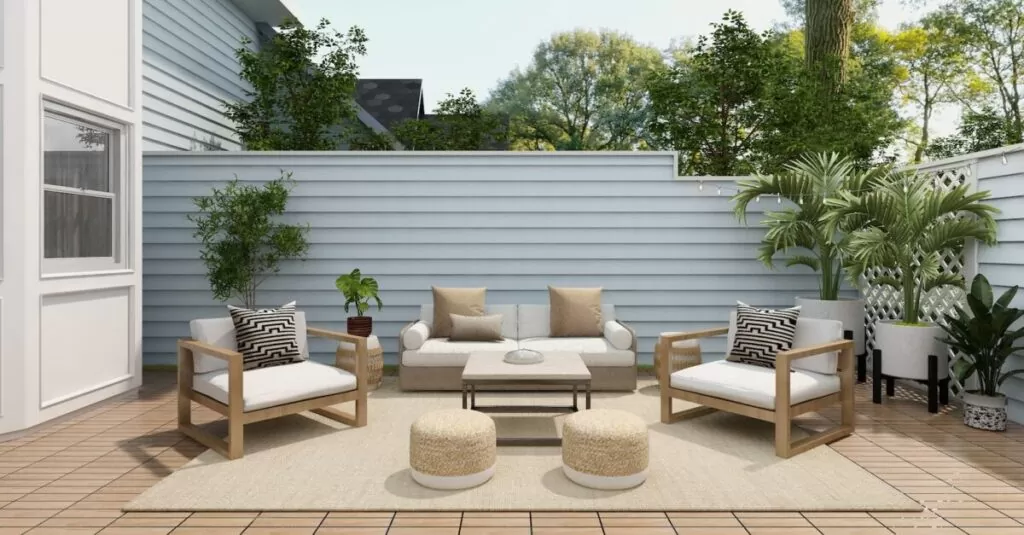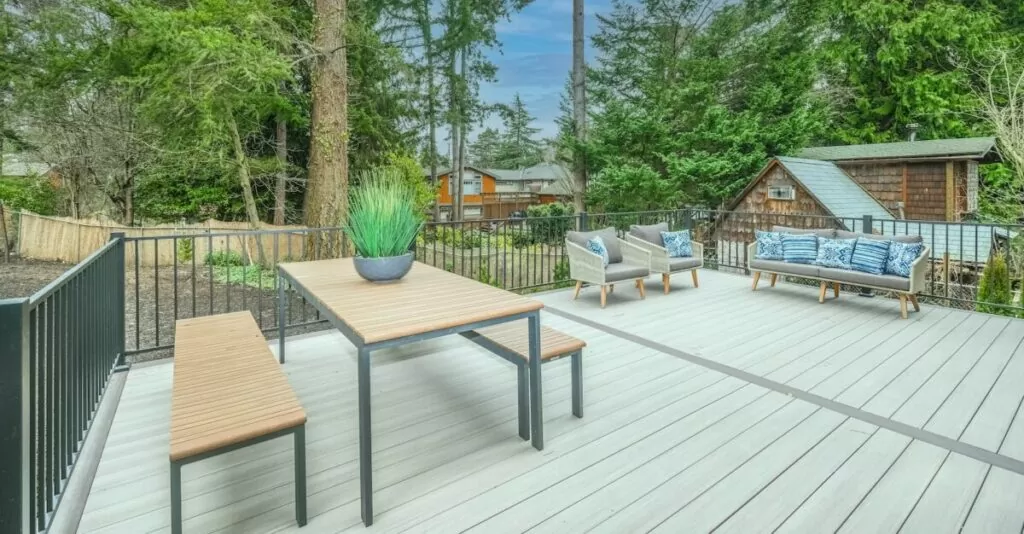Ahoy matey! If you’re looking to decorate your coastal home in style and make life by the sea even more enjoyable, outdoor furniture is the perfect way to do that. But it takes a little more thought to choose pieces that will last amidst the salty air and changing tides. Don’t worry, it’s nothing aye and matey can’t handle. From seaside chairs to coastal tables, let’s take a gander at the best outdoor furniture for coastal homes. Before you know it, your seaside abode will look spic-and-span and be the talk of the town!
When selecting outdoor furniture in a coastal home, it’s important to think about both style and durability. Some popular options include synthetic rattan and wicker, which offer an organic look and are lightweight and airy.
Teak is another good choice—it’s extremely durable and can stand up to even the harshest saltwater conditions.
For added protection against the elements, stainless steel, marine-grade aluminum, and composite materials like poly lumber are all good options as they are corrosion resistant and easy to maintain. Many of these materials have been designed to be fade-resistant to retain their original color even after years of use.
If you want something comfortable and low maintenance, opt for a cushion made from waterproof fabrics such as Sunbrella. Whatever option you choose, make sure it’s suited to your environment so you can enjoy your outdoor space for years to come.
Outdoor Furniture for Coastal Homes
When finding the perfect patio furniture for coastal homes, there are a few things to consider. For starters, coastal climates are often on the windy side and you don’t want your outdoor furniture blowing away or becoming damaged from high winds. You should choose pieces that are durable, weatherresistant and preferably made from materials like aluminum or plastic. Another factor to consider is saltwater spray or salty coastal air. If the furniture isn’t treated for this environment, it can become corroded and rusted in no time at all. Alternatively, selecting pieces that will withstand a salty climate – like aluminum or stainless steel frames – is also important. Additionally, as most coastal climates have lots of sun, you’ll want to select pieces with ultraviolet light resistant upholstery fabrics as well as waterproof fabrics to prevent fading and sun damage.
When choosing your backyard furniture, it’s essential to remember that many items inside your house may not work in a coastal climate. This includes items such as teak wood which has one of the highest heat conductivity ratings and can quickly become too hot in the hot summer sun. So if you’re designing an outdoor space for your coastal home, be sure that the materials selected are appropriate for the climate and environment you live in.
With these factors in mind, you can ensure that you find the perfect furniture pieces for your coastal home. In the next section we’ll explore what exactly constitutes “coastal style” so you know how to best approach styling your outdoor space so it complements its unique setting.

What is Considered Coastal Style?
One of the unique aspects of decorating a coastal home is figuring out what type of furniture works best. This can often be tricky, as there exists a wide variety of interpretations of coastal style. While some people may simply define it as light and airy, rattan furniture with nautical touches, or bright colors, this is actually a very broad description. To help narrow it down, let’s take a closer look at what truly encompasses coastal style and why certain pieces work better than others.
For starters, consider the environment in which people live near the coast. If you’re living on the beach or in proximity to one, you’re surrounded by natural elements like sand, sun and surf. This can translate into elements such as driftwood and bleached wood finishes for tables, coffee tables, sideboards and other furniture pieces to evoke the natural look and feel of the oceanfront atmosphere. Touches like white washed wood pieces with rope detailing enhance a coastal aesthetic with items that are reminiscent of boats and wharfs nearby. Alternatively, some choose to go for the classic “beachy” look featuring bright colors like turquoise or coral along with accents like starfish and marine blue glass lampshades inside their homes.
In addition to these visual elements, it’s also important to think about materials when shopping for coastal-style furniture. When looking for something that will stand up to the occasional saltwater breeze or high humidity levels typical near an ocean setting, it’s wise to select pieces crafted from durable materials such as stainless steel or teak that can withstand these environmental conditions. Durability should balance with comfort so look at cushions made from waterproof fabrics and resin wicker frames that still provide lots cozy seating options.

Durable Materials for Coastal Settings
When choosing outdoor furniture for coastal areas, the materials used are of top importance. Coastal homes are exposed to saltwater and humid climates, so even the most durable materials can degrade over time due to exposure to the elements. The key to finding furniture that will last is to look for pieces made from materials specifically designed for coastal living.
Wood is an especially popular choice for coastal homes as it creates a classic, beachy feel. Cedar wood and teak are ideal options as they are naturally weather-resistant and can survive moist, salty air with minimal maintenance. However, wood does require occasional sealing in order to maintain its waterproofing after contact with saltwater, sand or rain.
Metal and aluminum furniture is also a great option for coastal homes. These materials resist rusting and corroding due to their superior protection against humidity and saltwater exposure. Aluminum furniture comes in a wide range of styles and colors, making it easy to coordinate with your existing decor.
Finally, wicker furniture offers a lightweight yet sophisticated aesthetic suitable for coastal areas. To ensure maximum durability, opt for outdoor wicker made of resin or synthetic fibers that are designed to repel moisture while also offering superior resistance to sun damage.
Whatever material you choose, be sure to take climate conditions into account when selecting outdoor furniture for coastal settings. By investing in pieces made from durable materials, you can look forward to years of enjoyment outdoors with family and friends.
As choosing the right materials is essential when shopping for outdoor furniture discovered for coastal homes, the next step is selecting rustproof options that will not corrode or deteriorate over time.
Choosing Rustproof Options
When choosing patio furniture for coastal homes, rust-proof options are ideal to ensure that the pieces you choose last a lifetime. Typically, metal and aluminum furniture is waterproof and resistant to saltwater corrosion—key features when it comes to placing your furniture near the ocean or other salty bodies of water. Although metal and aluminum patio furniture pieces tend to be more expensive than wood or plastic options, they will last much longer and can usually be found in beautiful designs to match any home’s aesthetic.
If you choose furniture made from wood, plastic, or fiberglass, these materials are often not built to withstand exposure to saltwater and may need periodic painting or staining with protective coating agents to prevent them from warping or becoming corroded by the elements. Especially cheaper furniture from big box stores. It is cheap for a reason! While these materials may be less in cost initially, over time they may become substantially more expensive due to their lifespan being drastically shortened if not properly maintained.
Patio and Deck Furniture
Patio and deck furniture is an essential part of creating the perfect coastal home. This type of furniture not only helps to provide comfortable seating while entertaining guests, but it also provides a way to bring in some style and color that reflects the beauty of nature found in beach homes. When selecting patio and deck furniture for your coastal home, there are many factors to consider, including material selection, sturdiness, and weather-resistance.
When it comes to selecting the right material for outdoor patio and deck furniture, wood is often thought of as a classic choice. Not only does wood lend natural beauty to outdoor spaces, but it’s also relatively low maintenance when compared to other materials such as metal or wicker. Wicker is another popular option for outdoor furniture that is both sturdy and lightweight. It’s also a great option for coastal homes because it can stand up to salt air and humidity without easily corroding or deteriorating over time. On the other hand, metal lawn furniture is stronger, more durable, and often more affordable than other types of patio and deck furniture.

Seating Options for Beach Homes
Outdoor seating is essential for beach homes; from providing an inviting atmosphere for hosting guests to a quiet spot to relax and enjoy the view, finding comfortable furniture is important. Seating options come in a variety of forms, from cushioned sofas and chairs to sun loungers and benches. Each type has its advantages and disadvantages when considering the coastal environment, so it’s important to think carefully about what will work best for your home.
Cushions are often the first thought when it comes to outdoor seating; they provide comfort and support while creating a beautiful aesthetic with their vibrant colors, decorative accents, and plush feel. However, cushions can be hard to maintain in coastal environments since they can quickly accumulate salt flakes, mildew, stains, or discoloration due to weather conditions such as rain or sea mist. Alternately, some synthetic cushion fabrics can be waterproofed which can eliminate potential wear and tear caused by environmental factors.
Wooden furniture is another great option for seating in coastal homes; it’s timeless look creates a classic and inviting atmosphere that pairs well with the surroundings of a beach home. It is also more resilient than cushions against weather damage. However, rot and warping due to humidity levels can be an issue if not taken care of regularly and properly treated for outdoor use; choosing pieces made from marine grade teak wood or cedar planks are more resistant to damage from environmental elements.
Alternative seating materials such as wicker or rope mesh can offer a unique texture while also being sturdy enough to withstand salty air and winds. Wicker is most durable when treated with some form of UV coating that is built into the wicker stand while metal metal chairs may rust if not painted correctly. When considering either material, it may be helpful to base your decision off of geography -for instance if you’re located near a beach blessed with lush foliage then adding earthy materials would create an overall serene seaside atmosphere whereas metallic pieces would create a sleek modern feel perfect for a city-like location.
No matter which kind of seating you choose for your beach home, ensure that it’s durable enough handle all things related enjoying life at the beachfront including sand, dirt, salty air and anything else that life throws at it year round!
Best Furniture Pieces for Oceanfront Homes
When looking for the perfect pieces of outdoor furniture for a coastal home, homeowners need to consider several factors before making a purchase. Oceanfront homes require furniture that can withstand the elements, such as high winds and salty air, while also providing comfort and style.
The best type of outdoor furniture for an oceanfront home is solid teak and wicker. Teak is naturally water-resistant and highly durable, making it great for use outdoors. It also requires minimal maintenance due to its oiled finish that prevents rot and mildew build up. Wicker is another material often used in outdoor furniture and provides many advantages as well due to its lightweight but durable nature – ideal for areas prone to shifting sand.
So-called “all weather” furniture is another popular option for oceanfront properties because these pieces are specifically designed to be waterproof and fade-, crack-, or warp-resistant. This type of furniture is more expensive than traditional materials but can last longer when cared for properly.
Look for furniture with removable cushions that can easily be stored in a shed or spare room during inclement weather. This not only ensures that your whole set won’t become damaged by wind or rain but also provides more flexibility if you decide to rearrange your furniture or move inside during bad storms.
Choosing the right type of outdoor furniture for an oceanfront home takes careful consideration but it can make all the difference in your enjoyment of the space.

Alternatives to Outdoor Furniture Sets
When it comes to furnishing your coastal home’s outdoor space, an outdoor furniture set is a common go-to option. It gives you the convenience of buying multiple pieces at once and ensures that the furniture matches in look and scale. That said, a set isn’t the only way to go about styling your exterior area, and there are several great alternatives to consider as well.
In recent years, mix-and-match outdoor patio furniture has become increasingly popular for homeowners looking to add unique personality to their spaces. This look offers homeowners a chance to freely express their individual style without being tied down to a specific design of furniture. Mixing and matching furniture instead of buying a set gives you the ability to piece together different materials, colors, and shapes in creative ways. The more creative you are, the better!
If you prefer elements that match in terms of texture, color, pattern and style then purchasing different pieces from the same collection could be ideal for you. This type of mix-and-match approach limits how creative you can be with choices while still allowing you more freedom than buying a whole set outright would.
No matter which method you choose, keep in mind that investing in quality furniture will pay off in both performance and longevity – especially when it comes to outdoor items that need to stand up against tough weather conditions. Considering these elements carefully when deciding whether or not to buy an outdoor set or create your own unique combination of items will help ensure your outdoor space looks great for years to come.
Now that we have considered all of the different options available for furnishing a coastal home’s outdoor space, let’s turn our attention into drawing a conclusion on what pieces work best.
No, One-Size-Fits-All
When selecting the ideal outdoor patio furniture for coastal homes, there is no one-size-fits-all option. It’s important to consider the environment which these pieces will be placed in, and to take into account both aesthetic preferences and the comfort of the homeowner. Aluminum and wicker furniture are two popular choices thanks to their durability and low maintenance requirements, while natural materials such as teak can give an inviting vibe. Constructing custom pieces or mixing and matching materials is also a great way to ensure that you end up with the perfect pieces for your home.
In the end each homeowners must decide for themselves what type of outdoor furniture best meets their own needs. Different materials offer different advantages, so it is worth considering all options before settling on a final choice. However, no matter which material or combination of materials is selected, patio furniture for coastal homes will undoubtedly bring beauty and comfort to any home.

Todd is a co-owner of Patio Productions and has worked extensively in the furniture industry since 2002, when he started a company that designed and manufactured bathroom vanities. He now has a hand in all online business operations, including keeping tabs on industry trends and making sure Patio Productions remains an innovative leader in the outdoor furniture space. He lives just outside of Denver, Colorado with his wife, two boys, and two dogs. They live on a lake where they can make the most of the outdoor lifestyle. His favorite patio furniture sets are his Harmonia Living sectionals.

